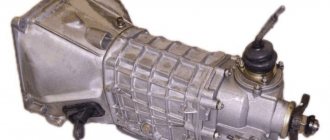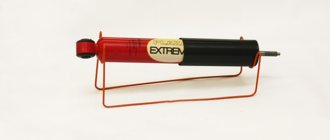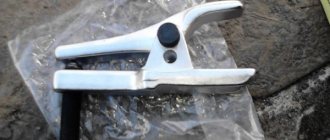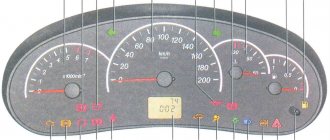What is it for?
This unit is an indispensable element in all-wheel drive vehicles. The Chevrolet Niva transmission and transfer case redistribute torque between the drive axles (of which there are two in the car). This mechanism, if necessary, increases the torque when moving (the so-called lowering).
It is worth noting that the transfer case is installed not only on all-wheel drive SUVs. Car lifts, cranes and other special equipment are often equipped with such a system.
Varieties
There are several types of these elements:
- Equipped with coaxial drive shafts. This type is used on many SUVs. It gained such popularity due to the use of a single main gear for both axles.
- With a misaligned driven shaft. There is no intermediate shaft here. The advantages of this system are high efficiency and noiselessness. Also, this box has a low curb weight.
- With drive axle drive blocking. It is also installed on the Chevrolet Niva. Here it is possible to use all the torque without slipping the wheels, which is very important when driving off-road. The front axle engages only on difficult sections of the road. On asphalt surfaces, the SUV has a single-wheel drive (only the rear axle works). This allows you to reduce fuel consumption and, if necessary, increase cross-country ability (when the drive “closes”). There is also an interaxle forced locking.
Modified versions
The Niva's standard transmission, for all its advantages, often causes uncomfortable noise in the cabin. This is generally related to the design, but using engineering developments, you can modernize it and make the car much quieter.
This approach has already been applied in VAZ-21213 cars; as a result, even at a speed of 100 km/h you don’t feel any unpleasant noise, you can talk calmly and hear your interlocutor without effort. For these purposes, a number of modernization methods have been used: from unloading the floor near the transfer case and manual transmission mounts, reducing the load on shaft bearings to smoothing out peak torques under conditions of increasing loads on the transmission. The effect is achieved by changing the mounting location of the front axle gearbox, which in the modernized version is suspended at a distance from the engine on rubber supports. This approach makes it possible to reduce to a minimum the reactive torque in the longitudinal-vertical direction and the noise level at speed.
The noise in the modernized Niva transmission is comparable to that of a Zhiguli. It becomes more comfortable to be in the car when driving off-road. Upgrade costs are negligible; modification requires only the master's understanding of the design itself and a little time.
About the device
Despite the difference in varieties, the structure and operating principle of these boxes are the same. How does the transfer case (Niva Chevrolet) work? This node includes several elements:
- Drive shaft.
- Center differential locking mechanism.
- The differential itself.
- Chain or gear transmission.
- Drive shaft of the rear and front axle.
- Downshift.
All this is controlled from the interior. There is a transfer lever for this. "Niva Chevrolet" has both locking and downshifting. The torque that goes from the main transmission to the transfer case is transmitted through the drive shaft.
Next, the torque force is distributed between the axes. This is where the center differential comes into play. This unit allows the wheels to rotate at different angular speeds. By the way, the differential itself can be of several types:
- Asymmetrical (distributes torque in different ratios).
- Symmetrical (distributes forces equally).
Transmission
1, 3 – Front wheel drive;
2 – front axle; 4 – clutch; 5 – gearbox; 6 – front driveshaft; 7 – intermediate shaft; 8 – transfer case; 9 – transfer case gear shift lever; 10 – differential lock lever; 11 – rear propeller shaft; 12 – rear axle; I – differential unlocked; II – differential locked; III – low gear engaged; IV – neutral position; V – high gear engaged
Transmission Specifications
The Niva car is all-wheel drive, i.e. All wheels are driven. All-wheel drive is permanent: torque from the engine is always transmitted to both axles at once (the axles are not disabled). This scheme increases the vehicle’s cross-country ability, while simultaneously reducing the load on the transmission units, but slightly increases fuel consumption.
The front and rear axles are connected through a center differential, allowing the front and rear wheels to rotate at different angular speeds depending on the trajectory and driving conditions. The center differential is located in the transfer case and is similar to the cross-axle differentials located in the front and rear axles. However, unlike them, the center differential can be forcibly locked (the locking lever is located on the floor tunnel). In this case, the front and rear driveshafts become rigidly connected to each other and rotate at the same frequency. This significantly increases the vehicle's maneuverability (on slippery slopes, in mud, snow, etc.), but worsens handling and increases wear on transmission parts and tires on surfaces with good grip. Therefore, the differential lock can only be used to overcome difficult areas and at low speeds. A warning lamp on the instrument panel serves to warn the driver that the locking mode is on.
You can engage the differential lock while the car is moving, if the wheels do not slip. Locking the center differential does not relieve the car from the danger of “diagonal hanging”, when one of the wheels on each axle loses traction with the ground - in this case, pour soil under the suspended wheels or dig it under the others.
To increase the torque supplied to the wheels, a low gear in the transfer case is used, its gear ratio is 2.135. The highest gear, intended for normal driving conditions, has a gear ratio of 1.20. Thus, the driver can use one of two rows of gear ratios - with a high or low gear in the transfer case. The total gear ratios of the “top” row (from 1st to 5th gear) are 4.40; 2.52; 1.63; 1.20; 0.98, “lower” – 7.82; 4.47; 2.90; 2.13; 1.75. The low gear in the transfer case is switched on before overcoming snowy, sandy areas, steep climbs, when towing loads, etc., when there is a lack of engine traction or for driving at very low speeds. It is necessary to engage a low gear in the transfer case in advance, with the car stationary, since the gear shift clutch does not have synchronizers. With some skill, it is possible to engage the highest gear even when driving at a speed no higher than 30–35 km/h, however, if possible, it is better to reduce the speed or stop.
A vehicle with permanent all-wheel drive places special demands on tires. They should be the same not only in size, but also in the degree of wear. Different tire rolling radii will cause increased wear on the differentials under normal driving conditions, and when the lock is engaged, increased wear on other transmission parts and wheel slip.
Video
Blocking
It is worth noting that on domestic SUVs the transfer case (including Chevrolet Niva) has a differential locking function. Thus, torque transmission can occur either symmetrically or asymmetrically, depending on the position of the shift lever in the cabin. To connect the front axle, a chain drive is used. This unit consists of gear links (driven and driven) and a drive chain. On modern SUVs, all-wheel drive is engaged automatically. But here the transfer transmission is made in the form of a bevel gearbox.
How does it work?
Its operating principle is quite simple. It consists in transmitting torque from the transmission to the drive shaft. Next, the forces are transferred to the center differential.
On old Nivas, the transfer case (Niva Chevrolet does not count) had a mechanism without locking. Now the car is equipped with a full-fledged differential with the ability to rigidly lock the teeth.
How does the transfer case work on a Chevrolet Niva?
Distributing fields . device
Every decent Jeep should have a transfer case in its design. VAZ 2121 Niva, like a decent jeep, also has RC on board, but not all owners use it properly, and we are not talking about the device. To dispel the aura of mystery in the handout, we tried to describe its structure and features.
Zae device and circuit
Everything you see in the drawing is called a demonstration case. It's easier to understand how it works given its purpose and features.
However, we have provided an open source schematic that fully describes the transmission housing design.
What do you need handouts
Why such difficulties? Create a second to increase torque output? Exactly. This will become clearer when we look at the purpose of distributing the VAZ 2121. It seems simple. handout material is necessary for the correct distribution of torque between the driving axles of the car. But not only for this. Another important feature of the transfer case is the increase in torque output. This is scientifically called a multiplier.
That is, you can highlight the following important functions of the handout:
- distribution of torque between the axles of the car;
- central differential lock;
- the ability to disable one of the drive axles;
- the ability to install a power take-off to ensure the operation of additional equipment;
- increased torque on the drive wheels due to the inclusion of a downshift.
VAZ 2121 Handout procedure
When road conditions worsen, it is necessary to engage a lower gear to overcome steep and long grades when driving on loose soil, on wet soil, and to obtain an even and stable low speed when driving on hard surfaces. It is worth it that at the factory it is forbidden to downshift until the car comes to a complete stop. Only then can you change to a lower gear and continue driving.
The transmission cabinet also provides full locking of the center differential. This involves an even distribution of torque between the axles, regardless of the load the wheels receive. This way, the car's ability to cross will be increased as each of the four wheels will rotate evenly. The differential can be locked while driving and at any vehicle speed. Naturally, when you downshift or upshift, you need to disengage the clutch.
Major problems in the transfer case
Most often, owners of an old VAZ 2121 complain about vibration and noise in the transmission, which does not fit into the image of a comfortable SUV. Noise and vibration occur during operation due to wear and tear of parts. Sometimes handouts can be anything. Often vibrations of drive shafts can be taken into account by motion vibrations. Failure to comply with the specified vibration value that appears on the driveshaft can result in bearing failure and premature seal and seal wear. This in turn leads to oil leakage.
The noise is noisy. If you experience vibrations and noise in the area when starting the machine, it is most likely the flexible coupling, or rather its mounting, that is to blame. The bolts may simply loosen under load, or the clutch itself may wear out, causing a characteristic noise to occur. If there is noise when turning or sliding, it is likely creating noise in the center differential.
There are a few other ways to determine the source of noise and vibration in a Niva section, but they all come down to calculating when the vibration occurs and trying to catch the noise with one touch. You need talent here.
But if the dispenser is working properly and not subjected to high loads, the oil changes over time and the condition of the universal joints and seals is monitored, then this will take a long time.
READ Heated seats not working Mazda 6 Gh
Transfer case operating modes
This mechanism can operate in five modes:
- Neutral is on.
- The differential is unlocked when the "lowering" is turned off. In this case, the torque is distributed in a ratio of one to two.
- The differential is locked when overdrive is engaged. Here, torque distribution is carried out automatically, depending on the quality of wheel grip on the road.
- Downshift is engaged and the differential lock is disabled. The transfer of forces occurs in the same ratio as in the first case.
- The differential is locked and the gearbox is engaged. In this case, all axles are rigidly locked together, including the axle shafts. Torque is produced unevenly, depending on the type of road surface (dirt, sand, etc.). In this mode of operation, the best cross-country ability of the vehicle is achieved. But driving with a constantly engaged downshift and with locks will not work. This increases the load on the transfer case bearings. The Chevrolet Niva will soon require serious intervention in the transmission. Fuel consumption also increases significantly, which greatly eats up the tires.
Differential locking
Sometimes you can come across a misconception about why a small handle is needed next to the shift lever on a Niva. Some car owners believe that it is needed to connect front-wheel drive. However, the front-wheel drive of this car is permanently connected. As is the rear one. Cars of the Niva family have permanent all-wheel drive. The handle actually serves to switch the operating modes of the differential of the transfer mechanism.
In the “forward” position, the differential operates as usual, but if you move it back, the differential is locked, and the forces from the motor are applied to the differentials of the axles, which makes the drive more rigid. It is worth noting that there are also special types of locks for front and rear axles.
In theory, when used in conditions where the car is stuck, it will be able to overcome the obstacle if there is sufficient traction on at least one wheel. In this case, it is better to lock the differential before overcoming an obstacle, but never after entering an area that is difficult to overcome. This application of locking will avoid wear and damage to the transmission.
It will be useful: The speed of the VAZ 2109 (carburetor, injector) floats: reasons, repairs
How to use it correctly?
There is a diagram on the shift lever. To engage a downshift, you need to move the lever to the right, up. To lock the differential, pull it all the way to the left. There are also Latin letters on the lever. So, L is a low gear, N is neutral, and H is high. Now let's find out how to use all this so that we don't have to repair the mechanism and change the transfer case bearings.
The Chevrolet Niva is a universal-purpose vehicle that is actively used not only on asphalt surfaces, but also off-road. So, if you have to overcome a ford or a puddle, you should stop completely and turn on a lower set of steps. Please note: it should only be turned on after a complete stop. Even at 5 kilometers per hour you will have problems with the transfer case. But you can lock the differential even while driving. This won't bring any surprises. Unless fuel consumption increases due to the constantly working two axles and axle shafts.
In what cases is it necessary to engage a downshift on a Chevrolet Niva? Its work will be needed when crossing “diagonals”, fords and during a long climb, which you climb slowly. Motorists often ask: is it possible to drive for a long time with a lock? Please note that it should only be enabled when absolutely necessary. Otherwise, the load on the teeth and shafts increases. If you drive like this on the asphalt at high speed, you will soon need to replace the transfer case on your Chevrolet Niva.
How to use a transfer case with a range multiplier on a Niva 2121
The normal position for the RK handles, ensuring adequate behavior on the road of good quality:
- Front - away from you Back - towards you
The special operating mode of the transmission is switched on not long before the car begins to overcome an obstacle (rut, mud, ford or rise). The transition to the lowest row must be done while stopping. Returning to top gear is allowed on the go, although it causes problems for beginners due to the lack of the usual synchronizer. It is somewhat more difficult to properly handle the forced manual locking of the center differential. On the contrary, it turns on when the car moves slightly (up to 20 km/h) due to misalignment of the grooves on the locking clutch, satellites and ring gear. To simplify turning the lever into the desired position, taking into account the Niva 2121 transfer case, pick up a small speed, then, shaking the steering wheel, pull the handle towards you.
It will be useful: How to install and replace valve stem seals on a VAZ-2107: video instructions
Problems can also arise when disengaging the lockout, as the clutch teeth literally catch on the ring gear. Engage reverse and, rocking the steering wheel, push the lever away from you. This action is performed immediately after overcoming a difficult section in order to avoid overloading the gearbox. It is most effective to disable the differential together with the transition to lower stages. In this case, only diagonal suspension of the wheels can stop a Niva 4x4, since standard inter-wheel locking is not provided. When performing the above operations, you must not give free rein to physical strength. An attempt to “push” the transmission will most likely result in expensive repairs.
Forced unlock
Sometimes it happens that the lock gets stuck - it cannot be turned off even when the car is completely stopped. The situation is quite common for the Chevrolet Niva. How to solve it? There is a sure way. To do this, engage reverse gear, accelerate a little and turn off the differential lock while driving. At a certain speed it can be easily “knocked out”. But if a similar lamp continues to light on your instrument panel, as in the photo below, the lock has not been turned off.
What to do in such a situation? It is necessary to turn on the first speed and try to turn off the unit again. Moving back and forth will solve the problem of a stuck differential. In general, it is recommended to turn on the center lock only in serious off-road conditions. At the intersection of dirt roads and sand dunes, a downshift is sufficient.
Overcoming a deep puddle
Often a dispute arises between motorists about how best to cross a ford with a transfer case. Some people prefer to “fly” into a puddle from acceleration, others prefer to downshift. If you get into a mud pit, there is a high risk of water hammer - water gets into the cylinders through the filter, and the engine “chokes.” To exclude this, many install a special snorkel. But you can do without it. A deep puddle should be overcome in second low gear. This is done so that in case of trouble (when the car starts to fail) you can switch to first gear in time and not stall. If you enter the water from acceleration (which is a better decision), remember that the wheels may get stuck in the middle of the journey. The engine power is not enough to turn the wheels - the car stalls, and the engine experiences a hydraulic shock.
Box repair
Often the transfer case cover (Niva Chevrolet is no exception) begins to leak oil through it. At the same time, its level in the box begins to fall slowly but surely.
In this case, the transfer case seals should be changed. Chevrolet Niva is equipped with three sealing elements. To replace these seals, you need to take the box out. It is best to do this on a lift or inspection pit. So, first we clean the box from oil stains and thoroughly blow it out. Next, we dismantle the driveshaft. An important point: when removing the bolts, inspect their condition. If the threads are “licked”, such bolts can no longer be used. And to eliminate imbalance of the driveshaft, make a mark on it at the dismantling points. Next, insert two bolts into the holes of the shaft flange and screw the nuts onto them. Use a small spatula to keep the element from rotating. Using a 24 mm socket, remove the nut and take out the flange washer. We also take the last part out. Next, take a flat-head screwdriver in your hands and remove the transfer case oil seal. The seating surface must be wiped with a dry cloth and a little new oil applied to the sealing element. Using a mandrel, press it into place. The remaining seals are installed in the same way. After completing the repair work, add oil to the transfer case. Niva Chevrolet loves gear lubricant with a viscosity of 80W90.
Other problems
Sometimes there is a knocking sound in the transfer case. The Chevrolet Niva is a more reliable car than the VAZ-2121, but such malfunctions should not be ruled out. The first thing you should pay attention to is the driveline. Previously, Nivas had crosses, the play in which caused a lot of noise and vibration.
If you have an old generation Niva, first inspect the crosspieces. As for the new versions, constant velocity joints are used here. There are no backlashes here. Therefore, we look for the reason in the alignment of the gears, which are located in the transfer case itself. If there are any backlashes or gaps, the gears must be replaced. It is also recommended to change the oil in the transfer case. An important point is that if the car overcomes a deep puddle, the lubricant in the box should be replaced as soon as possible. The presence of water in the transfer transmission oil reduces the life of gears and bearings. By the way, the latter also need to be checked and replaced. Perhaps the knocking is due to weak bearing seats. Motorists recommend using anaerobic sealant. They should treat the outer race of the bearings before installing the element into the grooves.
Another reason is the so-called helicopter. This is the splined part that secures the breakout with an elastic coupling. If such symptoms occur, check the wear of the splines. If there is play, replace it with a new one.
Features of the Nivov design
The features of the Nivov transmission include the presence of a center differential that connects the rear and front axles. As a result, the wheels can rotate not only at different angles, but also at different angular speeds, which significantly affects controllability in impassable roads.
The center differential is located in the transfer case and is similar in design to the cross-axle differential.
The key difference between the Niva’s center differential is the ability to lock when driveshafts rotate with the same characteristics. The center differential is manually locked only in difficult terrain conditions, when you need to overcome a large hole, rut or snow drift without slipping.
It will be useful: Wiring VAZ-2115: diagram
In practice, mechanical locking, although somewhat inconvenient, turns out to be better than the modern electromagnetic clutch used for these purposes. For example, the Renault Duster is not so easy to cope with the task in harsh off-road conditions, since the digital control unit can provide limited torque transmission. However, this effect will not be observed in a Niva with a mechanical lock.
Leaving the center differential locked will not only cause increased wear, but will also significantly reduce the vehicle's handling. The activated differential lock mode will be indicated by a lit indicator on the Niva dashboard. Please note that locking will not prevent one wheel from losing traction.
To overcome difficult areas, the transmission allows the use of a low gear with a high gear ratio (2.135); in the highest gear, the parameter is 1.2 and is intended for driving in normal conditions. The transfer case indicates different high and low gear modes. The lower one is turned on before entering a snowy area, unsteady soils, hills, and when a towed load is connected. The low gear compensates for the lack of power of the Niva’s “strong” engine and allows you to overcome difficult areas that only powerful cars can do.
Some drivers master the skill of shifting gears at speeds of 30-35 km/h. Otherwise, you will have to stop the car and perform the operation in the parking lot.
Please note that Niva requires a competent approach to the selection of tires, the quality of which can affect the degree of wear of the transmission in just one season. The tires must be the same in terms of wear and, of course, in size. Different characteristics will lead to increased load on the transmission and slipping in low gear, and during normal driving will increase wear on the differentials.











